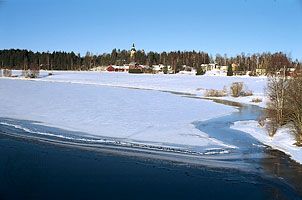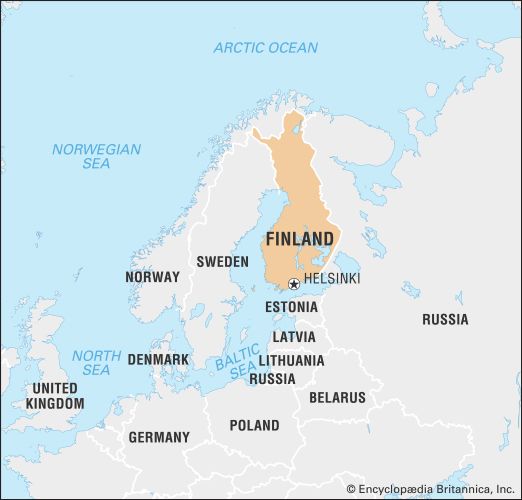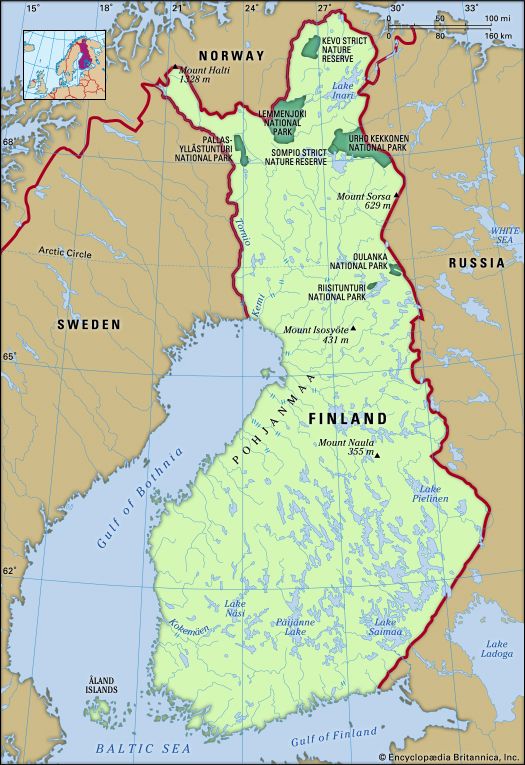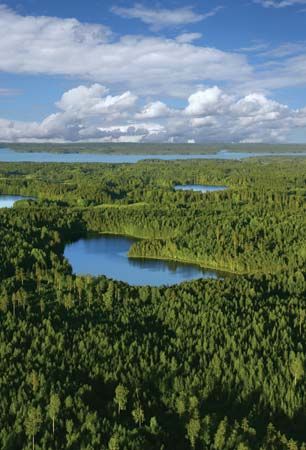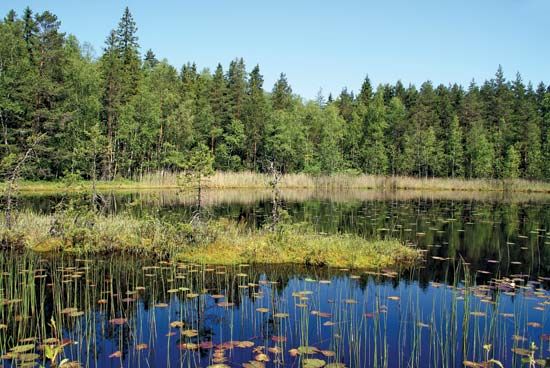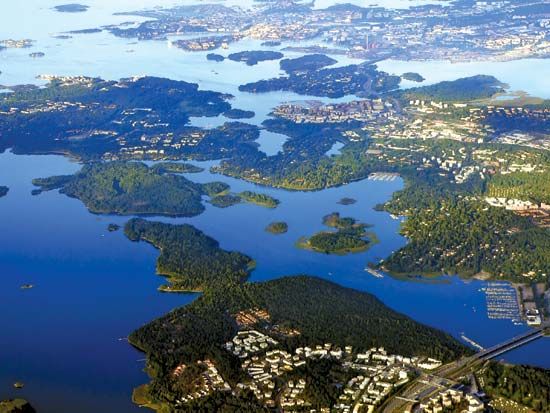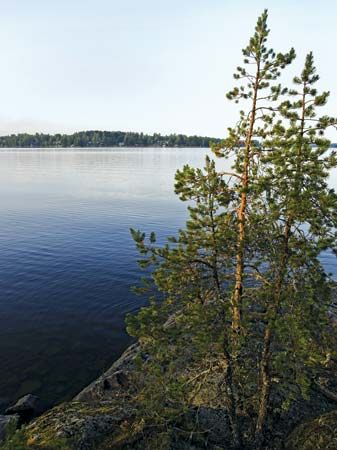The arts of Finland
Our editors will review what you’ve submitted and determine whether to revise the article.
News •
Finland’s national epic, the Kalevala, compiled in the 19th century by the scholar Elias Lönnrot from old Finnish ballads, lyrics, and incantations, played a vital part in fostering Finnish national consciousness and pride. Indeed, the development of almost all Finland’s cultural institutions and activities has been involved with and motivated by nationalist enthusiasm. This theme can be demonstrated in the growth and development of Finnish theatre and opera, in literature and music, in art and architecture, and also in sports. The festivals of various arts, held annually at places such as Helsinki, Vaasa, and Kaustinen, and Finland’s many museums show an awareness of the individuality and importance of Finland’s contribution to world culture. Savonlinna, in particular, is celebrated for its annual opera festivals.
Theatre, opera, and music
Drama in Finland is truly popular in the sense that vast numbers act in, as well as watch, theatrical productions. Besides the dozens of theatre companies in which all the actors are professionals, there are some in which a few professionals or even the producer alone are supplemented by amateur performers. And there are amateur theatrical companies in almost every commune.
The country’s most important theatre is the National Theatre of Finland, established in 1872 with Kaarlo Bergbom as producer and manager; its granite building in Helsinki was built in 1902. There are also several other municipal theatres. One of the most exciting in the country is the Pyynikki Open Air Theatre of Tampere, the revolving auditorium of which can be moved to face any of the natural sets. There are innumerable institutions connected with the theatre in Finland, including the Central Federation of Finnish Theatrical Organizations. There is a wide repertory of Finnish as well as international plays. The Finnish theatre receives some degree of government assistance.
The main centre for opera is the Finnish National Opera in Helsinki; the Savonlinna Opera Festival takes place every summer. The international success of Finnish singers such as Karita Mattila, Jorma Hynninen, and Soile Isokoski has added to the continuing national enthusiasm for opera. Several Finnish operas, including The Last Temptations by Joonas Kokkonen and The Horseman by Aulis Sallinen, gained notoriety in the late 20th and early 21st century.
The dominant figure in Finnish music during the first half of the 20th century was Jean Sibelius, the country’s best-known composer, who brought Finnish music into the repertoire of concert halls worldwide. Other renowned composers include Magnus Lindberg, Kaija Saariaho, and Einojuhani Rautavaara. The Sibelius Academy in Helsinki is a world-famous centre of musical study. The city is also the location of the Helsinki Philharmonic Orchestra and the Finnish Radio Symphony Orchestra. The Sibelius violin competition and Mirjam Helin song competition are held there every five years. There are annual music festivals in Helsinki and several other cities. Internationally known Finnish conductors include Paavo Berglund, Esa-Pekka Salonen, Jukka-Pekka Saraste, and Osmo Vänskä.
Literature
Epic prose has played and continues to play an important role in Finnish literature. Seitsemän veljestä (1870; Seven Brothers) by Aleksis Kivi is considered to be the first novel written in Finnish. Other early leading prose writers include Frans Eemil Sillanpää, the winner of the Nobel Prize for Literature in 1939. Although Mika Waltari represented newer trends in literature, it was his historical novels, among them Sinuhe, egyptiläinen (1945; The Egyptian), that brought him fame. Väinö Linna, a leading postwar writer, became known for his war novel Tuntematon soltilas (1954; The Unknown Soldier) and for the trilogy Täällä Pohjantähden alla (1959–62; Under the North Star). Other novelists have written in shorter forms, but the broad epic has remained popular, particularly among writers describing the contradictions in Finnish life from the turn of the century to modern times. One of the central figures in the Finnish modernist movement of the 1950s was poet and playwright Eeva Liisa Manner, perhaps best remembered for her poetry collection Tämä matka (“This Journey,” 1956). Other well-known Finnish authors include Kari Hotakainen, Leena Lehtolainen, Rosa Liksom, Asko Sahlberg, and Johanna Sinisalo.
Literature written in Swedish has had a long tradition in Finland. Among 19th-century writers, Johan Ludvig Runeberg, the national poet, and Zacharias Topelius played leading roles. Later 20th-century poets such as Edith Södergran had a strong influence on the modern poetry of both Finland and Scandinavia. One of Finland’s most beloved and widely translated authors, Tove Jansson, wrote her many books about the Moomin family in Swedish. The Swedish language continues to be used in Finnish literature, and writers such as Kjell Westö, Märta Tikkanen, Monika Fagerholm, and Jörn Donner are widely read in Finland and abroad.
Art, architecture, and design
From the time that the Kalevala inspired the paintings of Die Brücke Expressionist Akseli Gallen-Kallela, there has been a distinctive school of Finnish painters, but the Finnish artistic genius has been continually drawn to three-dimensional work. Sculpture is important, highly abstract, and experimental; Eila Hiltanen’s monument to Sibelius in Helsinki is composed of chrome, metal, and steel tubes.
Modern Finnish architecture is among the most imaginative and exciting in the world. Its development was closely allied to the nationalist movement, and among its pioneers were the internationally renowned Eliel Saarinen, whose work is exemplified by the National Museum and the Helsinki railway station, and Lars Sonck, whose churches in Helsinki and Tampere are particularly notable. Finnish women were also early innovators as architects, including Wiwi Lönn and Signe Hornborg, the latter one of the first formally trained female architects in the world.
In the 20th century the idea of functionalism was developed by Gustaf Strengell. In the 1920s Alvar Aalto and Erik Bryggman began experimenting with regional variations on the International Style. Among the most striking examples of Aalto’s work are the Paimio Sanatorium, the library at Viipuri, and Finlandia Hall, a concert and congress hall in Helsinki. There is general experimentation, using concrete and metals, in Finnish industrial buildings and flats and in environmental design, as at the garden town of Tapiola outside Helsinki. The new generation of architects has continued these standards. Architects such as Juha Ilmari Leiviskä, known for his innovative churches, and Pekka Helin and Tuomo Siitonen, whose flexible and adaptive working spaces are intended to encourage creative thinking, have been lauded at home and abroad.
Finnish design—especially in glass, porcelain, and textiles—became internationally known during the postwar period. Factories such as the well-known Arabia and Marimekko in Helsinki have given artists a free hand to develop their ideas and skills. Tapio Wirkkala, Kaj Franck, and Timo Sarpaneva in glassware, Marjatta Metsovaara in textiles, and Dora Ljung in ryijy, a type of knotted pile-weave rug, are among the best-known designers.



